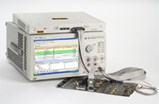Agilent Technologies, Astek Deliver Industry-First HyperTransport 3 Test Solution

Santa Clara, CA, and Colorado Springs, CO - Agilent Technologies Inc. and Astek Corp. recently announced the first logic analysis solution for HyperTransport 3 (HT3) using an interposer probe. The interposer is designed to enable access to HT3 buses on a computer system, allowing R&D engineers to debug, test and verify compliance of 8- and 16-bit 5.2 Gb/s HT3 links.
The test solution combines Agilent's 16950B logic analysis module and software with Astek's HT3 Logic Analyzer Interface (LAI). The protocol software decodes and displays incoming data on the logic analyzer; the interposer probe technology provides DC coupling while minimizing impact to the system under test.
Current HT3 bus architectures operate at bus speeds of up to 5.2 Gb/s. These high-speed signals along with DC-level startup conditions have made it almost impossible to use typical AC-coupled probe architectures (snooping probe) without significantly affecting the measurement. The Interposer probe is a DC-coupled probe that acts as a liaison between the CPU and the downstream device, and sends a buffered copy of the link data to the LAI for analysis. The end result is very clean system eyes that are not degraded by a snooping probe.
"Astek has worked closely with AMD to develop and integrate the Interposer into Astek's HT3 LAI solution," said Kevin Guy, president of Astek Corp.
"The Agilent/Astek HT3 logic analysis solution provides Hypertransport 3 system designers with a robust and complete toolset to help design, develop and test their systems," said Jeff Underhill, HPC business development manager, Server/Workstation Division, AMD and Ecosystem Chair of the HyperTransport Consortium. "This test tool set is scalable and built to evolve as AMD delivers increased levels of performance and efficiency in our best-in-class platforms."
Benefits of the Agilent/Astek HT3 test solution include:
- logic analysis triggering and decoding at the packet level with either raw 36-bit pattern matching or menu-driven listed commands (text description).;
- four pattern matchers in each Astek LAI, which can be used with the Agilent packet decoder software to set up complex triggering sequences;
- ability to expand the triggering capability (ranging) by inserting "don't care" in the raw pattern matching field;
- enhanced No Operation (NOP) filtering capability allows the user to select NOPs or NOPs with flow control; and
- ability to trigger other Agilent equipment to solve complex system problems.
SOURCE: Agilent Technologies Inc.
